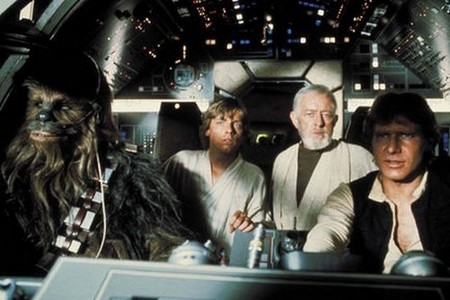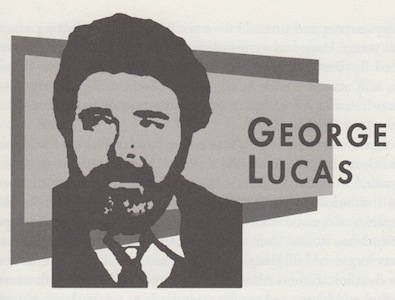
Born: May 14, 1944, Modesto, CA
Speed stirs the beast. Fast-paced action and a hustling camera suck the thrill seeker in us into the scene.
—John Boorstin
Ironically, the unique filmmaking gifts of George Lucas were first revealed in a slow, methodical futuristic story he made into a student film in 1965. THX 1138, later remade as Lucas’s first feature in 1971, showcases the director’s early attempts to experiment with pacing. He would use this knowledge to a different effect in his Skywalker trilogy, whose dogfight scenes would have an earth-shattering influence on films to come. Lucas increased the speed of films through editing and exhilarated audiences by overloading their senses. Through the experimental pace of Star Wars (1977), Lucas discovered that the human eye was able to distinguish nearly twice as many shots as traditional films used at the time. Movies suddenly got much faster.
Editor’s note: The essays of Scott Smith’s 1998 book, The Film 100, are being republished in their entirety here on Keyframe, not as the last word on cinema, but as a starting point for further discussion. Please join the conversation. To view the entire Film 100 list and find links to all the essays, please visit Reintroducing the Film 100.
After leaving the USC film school in 1968, Lucas found work with fellow alumnus Francis Ford Coppola on Finian’s Rainbow (1968) and The Rain People (1969) before getting an opportunity to direct his own features.
The breakthrough film for Lucas was the mainstream American Graffiti (1973), a fond remembrance of the director’s adolescence shot in just twenty-nine days outside his hometown north of San Francisco. Lucas used a large collection of vintage hotrods and period costumes to re-create the life of 1962 teens. Editing the film in close collaboration with editor Verna Fields and his wife Marcia, Lucas created what started as a frivolous romp through yesteryear and turned into a comment on the fleeting innocence of American youth. Hailed as a truly original work, American Graffiti was Oscar-nominated for Best Picture, Best Film Editing, Best Screenplay and Best Director, and actress Candy Clark received a Best Supporting Actress bid. The film ushered in a nostalgia craze of fifties rehash and eventually a sequel, More American Graffiti (1979).
Most significant was the film’s soundtrack, a collection of sock-hop oldies that was released as an album and sold well throughout the decade. Its success spawned literally thousands of soundtrack recordings that are now a staple of the industry. The heavy reliance on recordings of popular music would spark a dramatic shift in movies away from original compositions. Martin Scorsese, Robert Zemeckis, Oliver Stone, Barry Levinson and many more directors would fill their subsequent soundtracks with rock ‘n’ roll classics; Woody Allen, Robert Altman, Peter Bogdanovich and others would use jazz, rhythm and blues and country standards to establish mood and period. The Lucas soundtrack influenced the majority of films made since the release of American Graffiti, and its solid success as a hit record, particularly its consistent sales over the years, served as a valuable lesson to Lucas about the importance of merchandising.
For his next project, Lucas consulted with literary expert Joseph Campbell to arrive at a script that used timeless elements of myth and religion. Lucas added traditional symbols of good and evil and pitched the story to various studios as a western set in space. The strange characters and ambitious sets would require expensive costumes and labor; most studios rejected the film, but 20th Century Fox proposed a strict budget and agreed to go ahead.
The production of Star Wars (1977) was troubled by casting disputes and delays with set construction. Unsure that they had made a sound investment, Fox executives asked special effects pioneer Linwood Dunn to tour the Lucas project under the guise of a friendly visit and closely examine the working methods of the extremely young and inexperienced staff of model makers, animators and student filmmakers. Dunn was shown outlandish monster creations and was taken step-by-step through the special effects of the starfighter sequences. When he reported back to Fox, Dunn assured the studio that the wunderkinds seemed to have their hands on something new and remarkable.
Star Wars became a phenomenal hit, shattering all previous box office records. Produced for under $10 million, it grossed more than $400 million worldwide. Fans of the film boated about seeing it hundreds of times, and sequels The Empire Strikes Back (1980) and Return of the Jedi (1983) reaffirmed the mysterious lure of the original. In 1997, the entire trilogy was re-released in a special edition with some minor new sequences edited into the story with the benefit of computer-generated images. Again, the series excelled at the theaters, breaking records twenty years after its initial release and introducing the films to a new generation of moviegoers. The unwavering popularity of Star Wars is still central to the sales of video games and merchandise today.
But the success of Star Wars was about more than special effects. The breathtaking pace of the scenes, edited by Lucas in a hands-on collaboration with his wife, resulted in a major advancement in the understanding of film. Lucas increased frame rates and used optical zooms to create lightspeed space flight. To avoid the graininess of these effects on 35mm film, Lucas switched to the 70mm format. He researched the cowboy-and-Indian battle sequences in John Ford westerns and mimicked their mixing of raw action with character vignettes. Lucas raised the expectation of action and effects in all genres, not simply space epics. Today’s editors are constantly challenged by the pace of Star Wars and its imitators.
A wildcat mentality followed the success of Star Wars in 1977. The combined success of Steven Spielberg’s Jaws (1976) and Lucas’s films established the era of the blockbuster. Industry pundits felt that special effects and fantasy were the key in convincing consumers that rising ticket prices were justified. To strike it rich, producers searched for stories that lent themselves to explosions, spaceships and monsters. Lucas developed a cottage industry by offering his Industrial Light & Magic company’s visual effects services to other filmmakers for such spectacles as Poltergeist (1982), Terminator 2: Judgment Day (1991), Jurassic Park (1993), Jumanji (1995) and Twister (1996), as well as most of the Back to the Future comedies, Indiana Jones adventures, and Star Trek features.
To read all the republished articles from ‘The Film 100,’ go to Reintroducing the Film 100 here on Keyframe.




